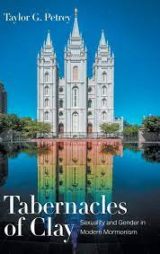Articles/Essays – Volume 54, No. 3
Unpacking Gender and Sexuality in Contemporary Mormonism Taylor G. Petrey, Tabernacles of Clay: Sexuality and Gender in Modern Mormonism
Inevitably at some point, due to structural white patriarchal privilege and a central and abiding concern with discrete gendered bodies and heteronormative relations, the teachings of the Church of Jesus Christ of Latter-day Saints will reinforce interlocking systems of oppression based on gender, race, class, culture, and sexuality. Taylor Petrey in Tabernacles of Clay: Sexuality and Gender in Modern Mormonism not only explores those structures of inequality within the Church discourse but also shows that for the most part gender construction is much more complex, fluid, and untidy than official Church teachings would have us believe.
The contribution this book makes to Mormon scholarship is significant. In addressing the gap in academic literature on gender, sexuality, and contemporary Mormonism, Petrey offers a comprehensive overview of the contemporary Church rhetoric on gender and sexuality that construct sexualized embodiment as both objects and agents of Mormon practices. Drawing upon queer theorists such as Judith Butler, Michel Foucault, Thomas Laqueur, and Eve Sedgwick, Petrey convincingly shows the extent Mormon gendered identity is socially constructed by interactions shaped by historical and cultural context. By ordering the chapters into specific periods of significant change in LDS teachings on gender and sexuality, Petrey captures the ways Church leaders are both centrifugal (pushing outward from the center) and centripetal (drawing things toward the center) in producing ideas of gender as a fixed, eternal characteristic. To demonstrate, in chapters 1 and 2, which center on interracial marriage and attitudes toward homosexuality during the 1950s and 60s, Petrey locates distinctive Mormon texts and teachings within the wider societal discourse on race and sexual relations in America. In doing so, he offers a more complex, nuanced explanation of Church teachings on gender, sexuality, and race that “even in Mormonism there is no ‘being’ to gender, only its ‘becoming’ through regulated norms” (222).
However, this book is much more than a historiography of gender and sexuality. Petrey brings together three areas of Church activity—public discourse, programs, and political campaigns—to question to what degree Church boundaries on gender and sexuality are formed and informed in a particular time, place, and context, and are not necessarily related in any clear way to doctrine. For example, in the 1970’s as feminist activism worked toward dismantling patrarichal structures in public and domestic spaces, Spencer W. Kimball began promoting “companionate patriarchy” (120), which positioned heterosexual couples as the foundation of the idealized Mormon home, where husbands and wives are to work side by side, while still maintaining male authority. The shift toward promulgating a “soft egalitarianism” (119) continued, however, to reproduce American evangelical notions of “separate but equal” or complementarianism, thereby amplifying the way conservative Mormon teachings coincide with traditional religious models of gender. Similarly, during this time when writing about the changes in how Church leaders instructed members regarding sexual relations and birth control, Petrey shows the extent to which official doctrine and policy changes can be informed by and adapted to reflect shifts in mainstream societal norms. He also adroitly links the Church’s role in the Equal Rights Amendment debate to the Church’s later engagement with legal disputes over gay marriage in America, which he suggests continued in the elevation of the heterosexual family, rather than a patriarchal family, as a structure of gendered power.
Yet the doctrine and the teachings of Mormonism are but one aspect of religiosity. Lived religion often becomes a series of contested, unstable, and creative practices that allow new forms of religion to emerge, including negotiations of gender. Petrey himself notes that because this book focuses exclusively on Church leaders—who are overwhelmingly older, male, and white Americans—it offers only a partial explanation of how the Church frames “sexual malleability and heteronormative prescriptions for gay, lesbian, and queer individuals” (176). Notwithstanding, Petrey’s sensitive and influential insights provide a foundation for additional critical thought and research on gender and sexual embodiment that explores how Church members negotiate between official doctrine and lived religion.
With a less skillful writer, Tabernacles of Clay may have become a diatribe seeking to destabilize the institutional structure by introducing contested identities. Instead, by shifting the discourse from power disparities between American Mormon men and women to interrogate the intersections of gender, Mormonism, America, and sexuality, Petrey has delivered a substantive, considered, and transformative text. In a religion with seemingly standardized theology, programs, and cultural practices, documenting the tension between Church teachings on gender essentialism and narratives around sexuality challenges existing Mormon perceptions of gender as a fundamental, eternal, stable identity. Petrey offers the possibilities of resistance and transgression, as well as demonstrating compliance and conformity, to Mormon discourse on gender and sexuality, contextualizing Latter-day Saint religious beliefs within a broader societal understanding of gender roles and representation. Moreover, by showing the “ambiguity, fluidity, contradiction, and paradox” (223) around gender, Mormonism, and sexuality, Petrey makes informed and compelling arguments that illustrate the ways Mormons are subjected to systematic structural exclusion due to gender and sexual difference and equip readers to advance religiously grounded imperatives that all are equal before God.
Taylor G. Petrey. Tabernacles of Clay: Sexuality and Gender in Modern Mormonism. Chapel Hill: University of North Carolina Press, 2020. 288 pp. Paper: $29.95. ISBN: 9781469656229.
Note: The Dialogue Foundation provides the web format of this article as a courtesy. There may be unintentional differences from the printed version. For citational and bibliographical purposes, please use the printed version or the PDFs provided online and on JSTOR.


 Back to full Issue
Back to full Issue

